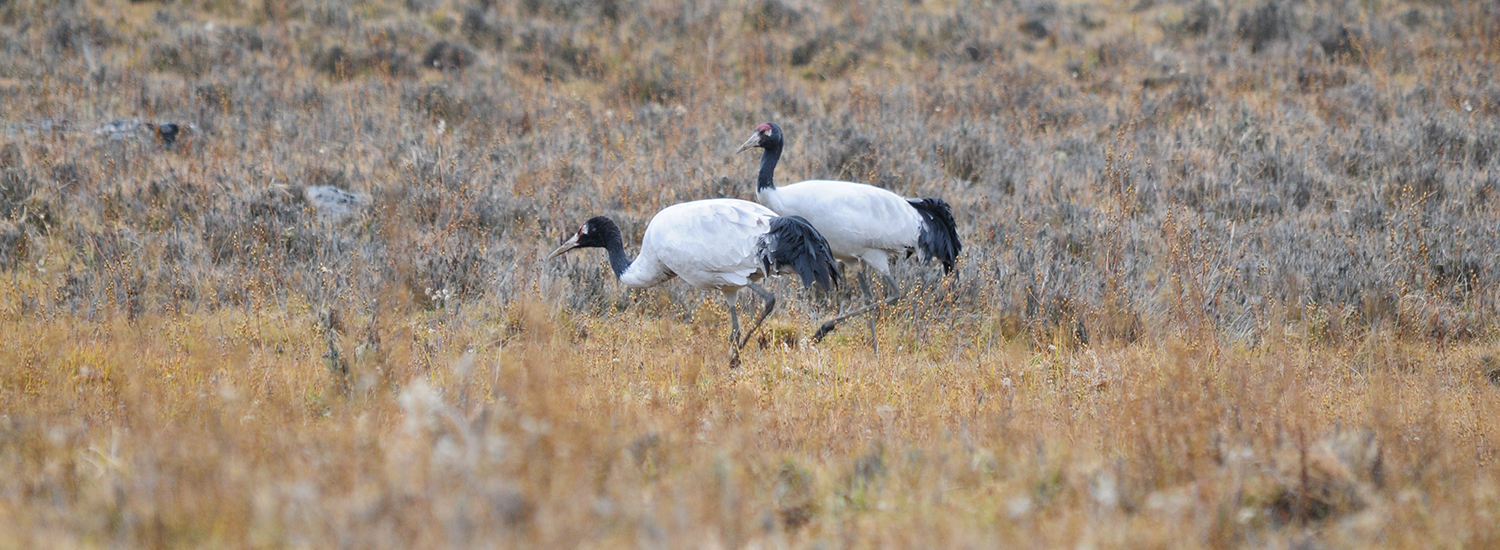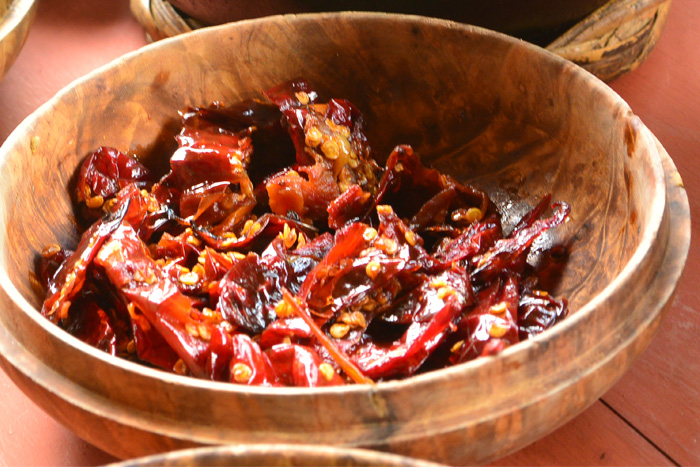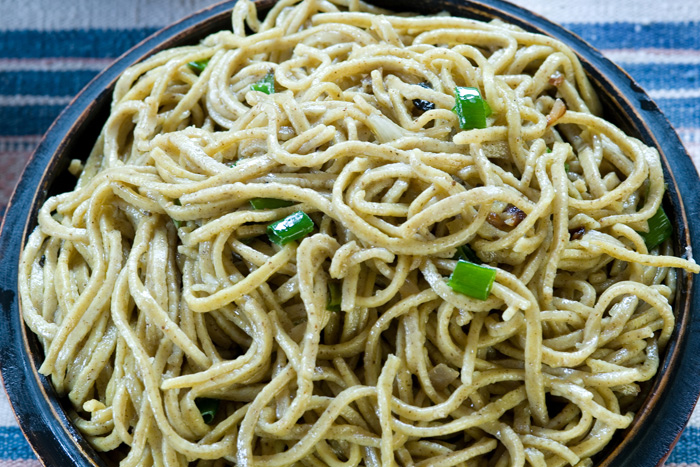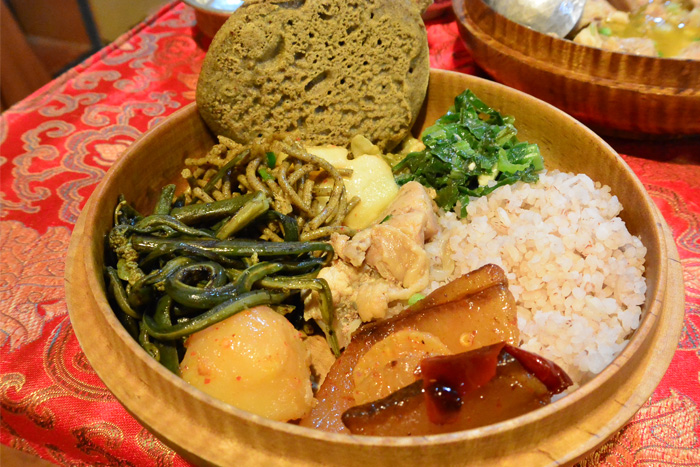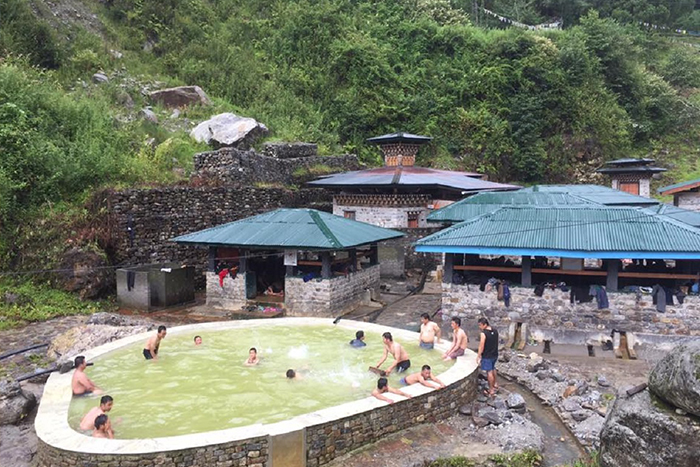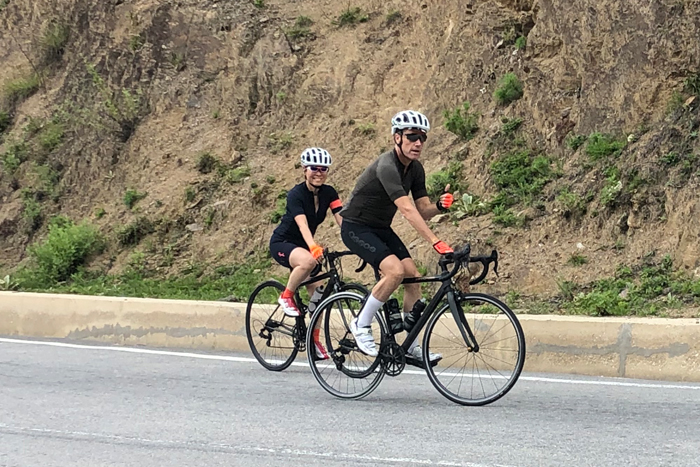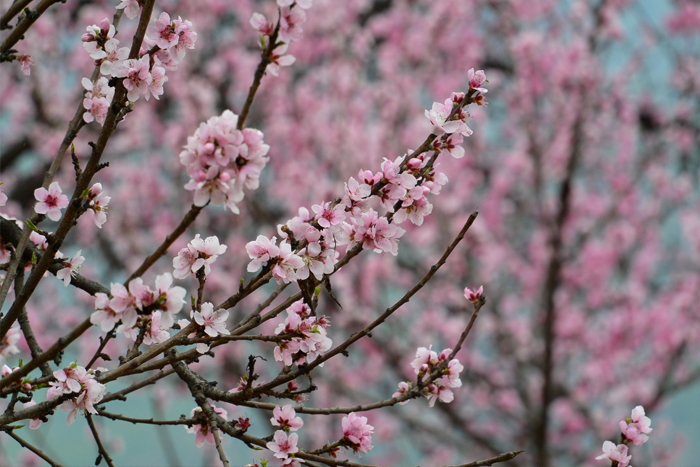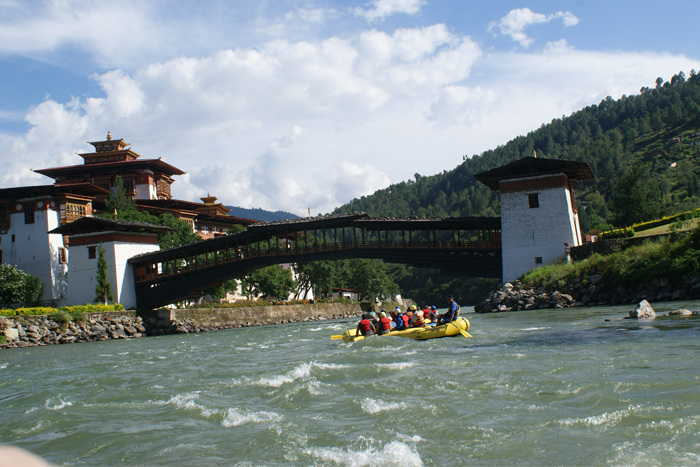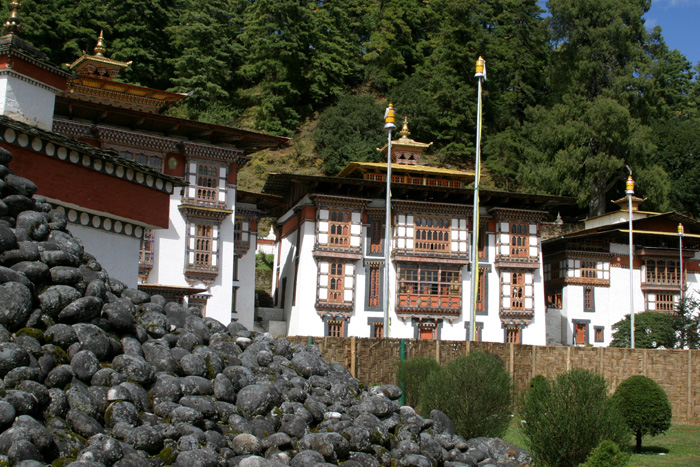Experiencing Bhutanese Victuals





Tour Summary
Duration: 8 days Entry: Paro Exit: Paro Areas covered: Paro, Haa, Thimphu, Wangduephodrang, Punakha, Trongsa, Bumthang
Categories: Special Interest Tours
Bhutan is a diverse country comprising of people speaking different dialects and cuisines, with different regions in Bhutan having their own specialties.
Generally, rice is a common ingredient of all Bhutanese dishes and is served together with different curries. The most popular is “Ema datsi”, chilly mixed with cheese. Bhutanese dishes are spicy and chilies are an essential part of nearly every dish. Spices include cardamom, ginger, chili peppers, Thingay (Sichuan pepper), garlic, turmeric and caraway.
Bhutanese eat a variety of meat too, the most common being pork, beef and chicken. These are prepared in different ways. Popular beverages include butter tea, tea, locally brewed ara (rice wine) and beer.
Travel across the country and experience the Himalayan Kingdom’s dishes and delicacies.
Generally, rice is a common ingredient of all Bhutanese dishes and is served together with different curries. The most popular is “Ema datsi”, chilly mixed with cheese. Bhutanese dishes are spicy and chilies are an essential part of nearly every dish. Spices include cardamom, ginger, chili peppers, Thingay (Sichuan pepper), garlic, turmeric and caraway.
Bhutanese eat a variety of meat too, the most common being pork, beef and chicken. These are prepared in different ways. Popular beverages include butter tea, tea, locally brewed ara (rice wine) and beer.
Travel across the country and experience the Himalayan Kingdom’s dishes and delicacies.
Day 1: Arrive at Paro international airport
You will land at Paro international Airport, after having experienced one of the most thrilling journeys of your lifetime – the flight to Paro, during which you experience a breath taking view of Mount Everest, Kanchenjunga and other famous Himalayan peaks, including the sacred Jomolhari and Mount Jichu Drake. The landing at Paro, considered one of the most challenging is an enthralling experience.
At the airport, you will be received by our company’s representatives. You will check in to the hotel and then served Bhutanese tea (Suja), which comprises Bhutanese tea leaves, salt and butter. After this, you will begin a sojourn of Paro valley, which includes visits to the National Museum of Bhutan and Paro Rimpong Fortress.
Lunch will then be served at a local hotel and you can choose Bhutanese delicacies, such as ema datsi (chilly and cheese), beef/yak pa (roasted beef or yak), beef/yak curry, roasted pig or pig curry. Roasted chicken or chicken curry can be served, too. Soup made from boiled bones and added spices, such as coriander is also a delicacy. Paro is Bhutan’s rice bowl and so you can choose between a variety of rice, including red rice, white ones etc. You will be served Bhutanese curd along with the meal.
After lunch, you can visit other places in Paro, such as ruins of Drugyel Dzong, Kyichu Lhakhang and then take a stroll around d town. You can treat yourself to Bhutanese tea and “zow” (a derivate of rice.) Later at dinner, you can help yourself to “ara”, locally brewed alcohol.
Day 2: Paro - Haa
During breakfast you will be served Bhutanese tea and “desi”, rice with butter, sugar and other ingredients such as cardamom. Another alternative can be “shamday”, rice mixed with minced meat and spices. You can also taste “Thub”, porridge made of rice mixed with pepper. If you do not want hot (spicy) dishes, alterations can be made.
After breakfast, we begin our journey to Haa and cross Chelela (Pass), Bhutan’s highest road point at an altitude of about 4,000 meters. The flora and fauna of the area will make your drive exciting.
Upon arrival at Haa, we will check into a hotel and order lunch. Haa is famous for its Hoentoe, aromatic buckwheat dumplings stuffed with turnip, greens, datsi (cheese), spinach and other ingredients. This is a dish that the people of Haa Valley serve when they celebrate a festival called as Lomba, the region's New Year. Other than this, you can taste common Bhutanese dishes served with rice, such as pork, chicken, beef, yak and even fish delicacies. Another common dish is “Momo,” dumplings stuffed either with meat or cheese.
After lunch, we will visit regions of importance in Haa, such as the abode of Aap Chundu (protecting deity of the region.) We can feast on the valleys beauty, before retiring for the day.
Night halt in hotel.
Day 3: Haa to Thimphu
You again have the choice to select Bhutanese dishes served for breakfast. After travelling through thick forests composed of pine trees, we reach Thimphu, Bhutan’s capital. We will check into a hotel, after which lunch will be served.
All Bhutan delicacies will be available and you can select what you want to have.
This will be followed by visits to the weaving centre, Memorial Chorten (a huge stupa) built in memory of the third King of Bhutan, Jigme Dorji Wangchuck, Changangkha monastery, built in the 12th century, Takin zoo, Buddha Point, where the statue of the world’s largest Buddha is being constructed; a Nunnery and the Arts and Craft school. You will also be taken to Sangaygang, a place from where you can have a bird’s eye view of Thimphu town and the surroundings. You will also visit the majestic and historic Tashichho Dzong, the main secretariat building, built in 1642. Today, this massive structure houses the office of the King, the Throne Room, some government Ministries and the State Monastic Body. It is also the summer residence of the Chief Abbot and senior monks.
Night halt will be at a hotel in Thimphu.
Day 4: Thimphu – Punakha/Wangdue
Your journey to Punakha, which is about 3 hours, will then begin. In about 45 minutes, you will reach the Dochula Pass (3,100m), from where visitors on a clear day can have a breathtaking glimpse of the eastern Himalayan range that consists of snow capped peaks with elevations ranging from 6000m to 7554m. Apart from this, the 108 stupas (chortens) at Dochula pass add to the beauty of the pass. The Pass is also exotic in flora and fauna.
The onward drive is a gradual ascend through beautiful forests of rhododendron and fields of dwarf bamboo, green meadows, beautiful wildflowers, gushing waterfalls and constantly changing vegetation. Lunch will be served at Lamperi and you can once again choose some of the Bhutanese delicacies served.
Before reaching Punakha/Wangdue, you will encounter several stalls on the way selling vegetables and Wangduephodrang district’s specialty, locally called as “Maykhu”. This resembles a pancake and is made from beaten rice.
Punakha was Bhutan’s capital until 1955 and is still home of the Chief Abbot during the winter months. Punakha Dzong (Fortress), built in 1637 by Shabdrung Ngawang Namgyal, stands like a giant ship on an ocean from afar. Build at the confluence of two rivers, Pho Chhu (male river) and Mo Chhu (female river), the Dzong was destroyed four times by fire and an earthquake in 1897. However, it has now been restored to its original splendor. The Dzong is an epitome of Bhutanese architecture.
Before reaching Punakha, you will visit the ruins of Wanduephodrang Dzong (Fortress), which was destroyed by a tragic fire in 2012. It was built in 1638 by the Zhabdrung.
Night halt will be at a hotel in Punakha.
Day 5: Punakha – Bumthang
After an early breakfast, we travel east crossing Pepela (Pass), traditionally the boundary between eastern and western Bhutan. We will stop for lunch at Chendebji, where a stupa resembling the one in Kathmandu stands. In what will be a buffet lunch, you will be served all dishes common in Bhutan, including the “Goep”(Tripe). Like most other meat dishes, it is cooked with plenty of spices, including chilies.
En-route, we will visit Trongsa Dzong, one of Bhutan’s most historical fortresses, from where the unification of Bhutan surfaced. We will also visit the Ta Dzong, formerly a watch tower.
Upon arrival at Bumthang, we will move into a hotel and proceed for dinner.
Bumthang is Bhutan’s premier producer of buckwheat and thus, the district has a couple of special dishes made from buckwheat. The most famous include, “Puta”, which is served in the form of noodles. Curd is usually served with the dish.
Another specialty is “Khuli”, Buckwheat pancakes, which is often served as an alternative to rice, along with ema-datsi.
During dinner, you can have a taste of these dishes.
Day 6: Bumthang halt
Just as rice was and still is the staple food of western Bhutan, maize is associated with eastern Bhutan. Most families of eastern Bhutan dry corn kernels in bamboo shoots and then ground it coarsely to make ‘Kharang’, which is mixed with rice and served with curry. Kharang is a dish that is recommended for diabetic patients.
A derivative of “Kharang” is “Kharang Bokpi,” flour that is produced during the making of “Kharang.” From Kharang Bokpi, one can prepare a special porridge called as “Yomri.” This is served especially as breakfast and as a dish for the sick who cannot take in solid food. One can also mix rice with the dish.
You can try this dish during breakfast.
After breakfast you can explore Bumthang valley, a blend of the abstract and concrete with innumerable legends surrounding the area.
You will be visiting Kurje Lhakhang where the Great Indian Saint Guru Padsambhava subdued a local demon and left his body imprint on a rock. The other is Jamphel lhakhang, which was built in the 7th century by Songsten Goembo, the Tibetan Buddhist King. Jakar Dzong (the fortress of white bird) built in the 17th century by Tenzin Rabgay (the fourth Desi) is another famous landmark.
You will also be visiting, Tamshing lhakhang built in 1501 by Terton Pema Lingpa (the founder of religious treasures). Kunchosum lhakhang and Membertsho (the flaming lake) are other places. Legend has it that Pema Lingpa discovered several religious text from the lake.
Lunch will be served in a local restaurant, where you will find other special dishes of the east. One is the “Bokpi,” flour smashed and then cooked and fried for a few minutes. Based on the ingredient, you can have “Kharang Bokpi”, a corn derivative; “Khu Bokpi”, rice derivate and those made from buckwheat and even wheat. These are served as alternatives to rice, along with curry.
Another dish is the “Bathu,” a semi-porridge consisting of small flour dumplings mixed and cooked in water consisting of bones. The flavor coming out of the bones make this disk special. Spices are also mixed and this dish is served especially when the weather is cold. It warms up the body.
During lunch, you can try out these dishes, too.
After lunch visit the cheese factory and take a stroll of Bumthang town.
Day 7: Bumthang – Thimphu
This will be a long journey back to the Kingdom’s capital. Lunch will be served at Chendebji and once again you can try out the Bhutanese dishes.
Halt at hotel in Thimphu.
Day 8: Thimphu- Paro (Departure)
After breakfast, you will be driven to Paro airport for your journey out of the country. Our representative will escort you.
Outline of few common dishes
Ema Datsi: This is the de facto National Dish of Bhutan. A spicy mix of chilies and the delicious local cheese known as Datsi. This dish is a staple of nearly every meal and can be found throughout the country. Variations on ema datsi include adding green beans, ferns, potatoes, mushrooms or swapping the regular cheese for yak cheese.
Momos: These Tibetan-style dumplings are stuffed with pork, beef or cabbages and cheese. Traditionally eaten during special occasions, these tasty treats are a Bhutanese favorite.
Phaksha Paa: Pork cooked with spicy red chilies. This dish can also include radishes or spinach. A popular variation uses sun-dried (known as sicaam).
Hoentoe: Aromatic buckwheat dumplings stuffed with turnip greens, datsi (cheese), spinach and other ingredients from the Haa Valley and is usually made during the Lomba Celebration (the region's New Year).
Red Rice: Bhutanese red rice, native to the Kingdom of Bhutan located in the Eastern Himalayas, is a unique, medium-grain variety. It is ready to serve in about 20 minutes and has a deep red color that fades to pink when cooked. Its flavor is complex, earthy and nutty, like a powerful brown rice, and each serving is nutrient-rich.
Goep (Tripe): Though the popularity of tripe has diminished in many countries it is still enjoyed in Bhutan. Like most other meat dishes, it is cooked with plenty of spicy chilies and chili powder.
You will land at Paro international Airport, after having experienced one of the most thrilling journeys of your lifetime – the flight to Paro, during which you experience a breath taking view of Mount Everest, Kanchenjunga and other famous Himalayan peaks, including the sacred Jomolhari and Mount Jichu Drake. The landing at Paro, considered one of the most challenging is an enthralling experience.
At the airport, you will be received by our company’s representatives. You will check in to the hotel and then served Bhutanese tea (Suja), which comprises Bhutanese tea leaves, salt and butter. After this, you will begin a sojourn of Paro valley, which includes visits to the National Museum of Bhutan and Paro Rimpong Fortress.
Lunch will then be served at a local hotel and you can choose Bhutanese delicacies, such as ema datsi (chilly and cheese), beef/yak pa (roasted beef or yak), beef/yak curry, roasted pig or pig curry. Roasted chicken or chicken curry can be served, too. Soup made from boiled bones and added spices, such as coriander is also a delicacy. Paro is Bhutan’s rice bowl and so you can choose between a variety of rice, including red rice, white ones etc. You will be served Bhutanese curd along with the meal.
After lunch, you can visit other places in Paro, such as ruins of Drugyel Dzong, Kyichu Lhakhang and then take a stroll around d town. You can treat yourself to Bhutanese tea and “zow” (a derivate of rice.) Later at dinner, you can help yourself to “ara”, locally brewed alcohol.
Day 2: Paro - Haa
During breakfast you will be served Bhutanese tea and “desi”, rice with butter, sugar and other ingredients such as cardamom. Another alternative can be “shamday”, rice mixed with minced meat and spices. You can also taste “Thub”, porridge made of rice mixed with pepper. If you do not want hot (spicy) dishes, alterations can be made.
After breakfast, we begin our journey to Haa and cross Chelela (Pass), Bhutan’s highest road point at an altitude of about 4,000 meters. The flora and fauna of the area will make your drive exciting.
Upon arrival at Haa, we will check into a hotel and order lunch. Haa is famous for its Hoentoe, aromatic buckwheat dumplings stuffed with turnip, greens, datsi (cheese), spinach and other ingredients. This is a dish that the people of Haa Valley serve when they celebrate a festival called as Lomba, the region's New Year. Other than this, you can taste common Bhutanese dishes served with rice, such as pork, chicken, beef, yak and even fish delicacies. Another common dish is “Momo,” dumplings stuffed either with meat or cheese.
After lunch, we will visit regions of importance in Haa, such as the abode of Aap Chundu (protecting deity of the region.) We can feast on the valleys beauty, before retiring for the day.
Night halt in hotel.
Day 3: Haa to Thimphu
You again have the choice to select Bhutanese dishes served for breakfast. After travelling through thick forests composed of pine trees, we reach Thimphu, Bhutan’s capital. We will check into a hotel, after which lunch will be served.
All Bhutan delicacies will be available and you can select what you want to have.
This will be followed by visits to the weaving centre, Memorial Chorten (a huge stupa) built in memory of the third King of Bhutan, Jigme Dorji Wangchuck, Changangkha monastery, built in the 12th century, Takin zoo, Buddha Point, where the statue of the world’s largest Buddha is being constructed; a Nunnery and the Arts and Craft school. You will also be taken to Sangaygang, a place from where you can have a bird’s eye view of Thimphu town and the surroundings. You will also visit the majestic and historic Tashichho Dzong, the main secretariat building, built in 1642. Today, this massive structure houses the office of the King, the Throne Room, some government Ministries and the State Monastic Body. It is also the summer residence of the Chief Abbot and senior monks.
Night halt will be at a hotel in Thimphu.
Day 4: Thimphu – Punakha/Wangdue
Your journey to Punakha, which is about 3 hours, will then begin. In about 45 minutes, you will reach the Dochula Pass (3,100m), from where visitors on a clear day can have a breathtaking glimpse of the eastern Himalayan range that consists of snow capped peaks with elevations ranging from 6000m to 7554m. Apart from this, the 108 stupas (chortens) at Dochula pass add to the beauty of the pass. The Pass is also exotic in flora and fauna.
The onward drive is a gradual ascend through beautiful forests of rhododendron and fields of dwarf bamboo, green meadows, beautiful wildflowers, gushing waterfalls and constantly changing vegetation. Lunch will be served at Lamperi and you can once again choose some of the Bhutanese delicacies served.
Before reaching Punakha/Wangdue, you will encounter several stalls on the way selling vegetables and Wangduephodrang district’s specialty, locally called as “Maykhu”. This resembles a pancake and is made from beaten rice.
Punakha was Bhutan’s capital until 1955 and is still home of the Chief Abbot during the winter months. Punakha Dzong (Fortress), built in 1637 by Shabdrung Ngawang Namgyal, stands like a giant ship on an ocean from afar. Build at the confluence of two rivers, Pho Chhu (male river) and Mo Chhu (female river), the Dzong was destroyed four times by fire and an earthquake in 1897. However, it has now been restored to its original splendor. The Dzong is an epitome of Bhutanese architecture.
Before reaching Punakha, you will visit the ruins of Wanduephodrang Dzong (Fortress), which was destroyed by a tragic fire in 2012. It was built in 1638 by the Zhabdrung.
Night halt will be at a hotel in Punakha.
Day 5: Punakha – Bumthang
After an early breakfast, we travel east crossing Pepela (Pass), traditionally the boundary between eastern and western Bhutan. We will stop for lunch at Chendebji, where a stupa resembling the one in Kathmandu stands. In what will be a buffet lunch, you will be served all dishes common in Bhutan, including the “Goep”(Tripe). Like most other meat dishes, it is cooked with plenty of spices, including chilies.
En-route, we will visit Trongsa Dzong, one of Bhutan’s most historical fortresses, from where the unification of Bhutan surfaced. We will also visit the Ta Dzong, formerly a watch tower.
Upon arrival at Bumthang, we will move into a hotel and proceed for dinner.
Bumthang is Bhutan’s premier producer of buckwheat and thus, the district has a couple of special dishes made from buckwheat. The most famous include, “Puta”, which is served in the form of noodles. Curd is usually served with the dish.
Another specialty is “Khuli”, Buckwheat pancakes, which is often served as an alternative to rice, along with ema-datsi.
During dinner, you can have a taste of these dishes.
Day 6: Bumthang halt
Just as rice was and still is the staple food of western Bhutan, maize is associated with eastern Bhutan. Most families of eastern Bhutan dry corn kernels in bamboo shoots and then ground it coarsely to make ‘Kharang’, which is mixed with rice and served with curry. Kharang is a dish that is recommended for diabetic patients.
A derivative of “Kharang” is “Kharang Bokpi,” flour that is produced during the making of “Kharang.” From Kharang Bokpi, one can prepare a special porridge called as “Yomri.” This is served especially as breakfast and as a dish for the sick who cannot take in solid food. One can also mix rice with the dish.
You can try this dish during breakfast.
After breakfast you can explore Bumthang valley, a blend of the abstract and concrete with innumerable legends surrounding the area.
You will be visiting Kurje Lhakhang where the Great Indian Saint Guru Padsambhava subdued a local demon and left his body imprint on a rock. The other is Jamphel lhakhang, which was built in the 7th century by Songsten Goembo, the Tibetan Buddhist King. Jakar Dzong (the fortress of white bird) built in the 17th century by Tenzin Rabgay (the fourth Desi) is another famous landmark.
You will also be visiting, Tamshing lhakhang built in 1501 by Terton Pema Lingpa (the founder of religious treasures). Kunchosum lhakhang and Membertsho (the flaming lake) are other places. Legend has it that Pema Lingpa discovered several religious text from the lake.
Lunch will be served in a local restaurant, where you will find other special dishes of the east. One is the “Bokpi,” flour smashed and then cooked and fried for a few minutes. Based on the ingredient, you can have “Kharang Bokpi”, a corn derivative; “Khu Bokpi”, rice derivate and those made from buckwheat and even wheat. These are served as alternatives to rice, along with curry.
Another dish is the “Bathu,” a semi-porridge consisting of small flour dumplings mixed and cooked in water consisting of bones. The flavor coming out of the bones make this disk special. Spices are also mixed and this dish is served especially when the weather is cold. It warms up the body.
During lunch, you can try out these dishes, too.
After lunch visit the cheese factory and take a stroll of Bumthang town.
Day 7: Bumthang – Thimphu
This will be a long journey back to the Kingdom’s capital. Lunch will be served at Chendebji and once again you can try out the Bhutanese dishes.
Halt at hotel in Thimphu.
Day 8: Thimphu- Paro (Departure)
After breakfast, you will be driven to Paro airport for your journey out of the country. Our representative will escort you.
Outline of few common dishes
Ema Datsi: This is the de facto National Dish of Bhutan. A spicy mix of chilies and the delicious local cheese known as Datsi. This dish is a staple of nearly every meal and can be found throughout the country. Variations on ema datsi include adding green beans, ferns, potatoes, mushrooms or swapping the regular cheese for yak cheese.
Momos: These Tibetan-style dumplings are stuffed with pork, beef or cabbages and cheese. Traditionally eaten during special occasions, these tasty treats are a Bhutanese favorite.
Phaksha Paa: Pork cooked with spicy red chilies. This dish can also include radishes or spinach. A popular variation uses sun-dried (known as sicaam).
Hoentoe: Aromatic buckwheat dumplings stuffed with turnip greens, datsi (cheese), spinach and other ingredients from the Haa Valley and is usually made during the Lomba Celebration (the region's New Year).
Red Rice: Bhutanese red rice, native to the Kingdom of Bhutan located in the Eastern Himalayas, is a unique, medium-grain variety. It is ready to serve in about 20 minutes and has a deep red color that fades to pink when cooked. Its flavor is complex, earthy and nutty, like a powerful brown rice, and each serving is nutrient-rich.
Goep (Tripe): Though the popularity of tripe has diminished in many countries it is still enjoyed in Bhutan. Like most other meat dishes, it is cooked with plenty of spicy chilies and chili powder.
Related Tour
-
Expedition of the healing waters
Duration: 10 days Entry Point: Paro, Western Bhutan...
-
Birds of Bhutan Tour
Duration: 21 days Entry Point: Paro, Western Bhutan...
-
Biking in Drukyul
Duration: 7 days Entry: Paro Exit: Paro Areas covered:...
-
Bhutan Botanical Tour
Duration: 12 days Best Seasons:...
-
Bhutan Photography Tour
Duration:13 days Entry: Paro, western Bhutan Exit: Guwahati,...
-
Rafting adventure
The crystal clear rivers of Bhutan are...
-
Meditating in Drukyul
Duration: 18 days Entry: Paro Exit: Paro...

